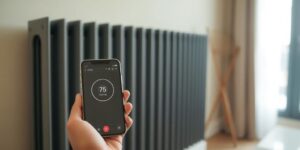In the world of smart technologies, smart home thermometers are indispensable. They help us monitor the temperature and humidity in our living spaces, contributing to a pleasant living environment. In this article, we present the best smart home thermometers for 2025, suitable for both indoor and outdoor areas. Whether you are looking for a simple device or a highly developed model, you will find the right solution for your smart home here.
Key Insights
- Pay attention to the correct protection class for outdoor thermometers, ideally IP65 for weather resistance.
- Wi-Fi thermometers not only provide precise measurements but can also be integrated into smart home systems.
- A hygrometer is useful for monitoring humidity and preventing mold growth.
- The placement of the thermometers is crucial for accurate measurements; avoid direct heat sources.
- Popular models like the Govee H5179001DE and Netatmo NWS1-EC offer a variety of features and are highly recommended.
The Coolest Smart Home Thermometers for Every Need

Sure, smart thermometers are super practical. But which one is right for you? Here are a few cool options, no matter what you need.
For Indoor Use: Govee H5179001DE
Do you want to check the temperature in your apartment without getting up? The Govee H5179001DE is your friend. Easily monitor room climate via app and keep everything in view. It’s easy to use and provides reliable data. Really nice if you like things uncomplicated.
For Outdoor Use: SwitchBot W3400010
Do you want to know if you need to water the plants or if it’s freezing outside? The SwitchBot W3400010 makes it possible. This device is weatherproof and shows you temperature and humidity. So you are always well-informed, whether it’s a garden party or a frost warning. And the best part: you can easily integrate it into your smart home.
For Precise Measurements: Netatmo NWS1-EC
If every detail matters to you, then the Netatmo NWS1-EC is just right. This device is super accurate and measures not only temperature but also humidity, air pressure, and even noise levels. Perfect for those who want to know everything in detail. Sure, the price is a bit higher, but you get premium quality.
Smart thermometers are really practical, but make sure they also fit your needs. Consider where you want to use them and which features are important to you. Then you will surely find the perfect model for your smart home.
What to Look for in Smart Home Thermometers
Sure, smart home thermometers are super practical, but before you grab the first one you see, there are a few things you should check. Otherwise, you might regret it later.
Measurement Accuracy and Range
How accurate is the device? And what temperature range does it cover? For indoors, it might not be that critical, but if you want to use it outdoors, it should be able to handle some freezing temperatures. Pay attention to the manufacturer’s specifications regarding measurement accuracy.
Connectivity: Wi-Fi or Bluetooth?
Wi-Fi is cool because you can access it from anywhere. Bluetooth is often easier to set up, but you need to be within range. Think about what is more important to you. Do you need a Wi-Fi thermometer or is Bluetooth sufficient?
Hygrometer Function: Useful or Not?
Do you really need a hygrometer that measures humidity? If you want to avoid mold or just want to know if the air is too dry, then yes. Otherwise, you can save your money. A good hygrometer can help you optimize the indoor climate.
Remember, not every thermometer is suitable for outdoor use. Check the protection class, especially if it’s supposed to be an outdoor thermometer. IP65 is a good start to ensure it doesn’t fail at the first rain shower.
The Best Wi-Fi Thermometers in Review

Okay, let’s take a look at the best Wi-Fi thermometers. There are so many on the market now that it’s easy to lose track. Here are a few that have performed really well in tests.
ThermoPro TP49: Affordable Basic Solution
Are you looking for a simple and affordable solution? Then the ThermoPro TP49 might be for you. It’s super easy to use and shows you the temperature and humidity directly on the display. However, be aware: it does not have Wi-Fi functionality. So you can’t access the data via an app. But for the price, it’s really great!
Ubibot WS1: Flexibility and Features
The Ubibot WS1 is a bit more high-tech. It not only offers temperature and humidity measurement but also other useful features. You can connect it via Wi-Fi and conveniently access the data via an app. Additionally, it stores the data in the cloud, so you can keep track of everything in the long term. If you’re looking for a bit more flexibility, the Ubibot WS1 is a good choice. You can use the Wi-Fi connection to synchronize the data.
Govee H5075: Smart Hygrometer
The Govee H5075 is a smart hygrometer that not only shows you the temperature but also the humidity. You can connect it via Bluetooth to your smartphone and access the data via an app. Additionally, you can set alarms when certain values are exceeded or not reached. This is especially practical if you have sensitive plants or want to avoid mold growth. The Bresser weather station is also a good choice.
Wi-Fi thermometers are really practical because you can always keep an eye on the temperature and humidity, no matter where you are. Additionally, you can often integrate them into your smart home system and automatically control things like heating.
Here’s a small comparison table:
| Model | Price | Wi-Fi | App Control | Cloud Storage |
|---|---|---|---|---|
| ThermoPro TP49 | Cheap | No | No | No |
| Ubibot WS1 | Medium | Yes | Yes | Yes |
| Govee H5075 | Medium | No (Bluetooth) | Yes | No |
So, depending on what you’re looking for, there’s something for everyone!
Where to Best Place Smart Home Thermometers?
Sure, a smart home thermometer is super practical, but where should you place it to ensure it provides accurate values? Here are a few tips so you don’t compare apples to oranges.
Avoiding Heat Sources
Imagine you want to measure the temperature in a room, but the thermometer is right next to the heater. Obviously, the result will be skewed, right? So, keep your thermometer away from radiators, fireplaces, stoves, and other heat sources. Direct sunlight can also affect the measurement. Remember, the thermometer should measure the room temperature, not the temperature of the heater!
Optimal Positioning for Accuracy
It’s best to place your thermometer in a location that reflects the average temperature of the room well. This means:
- Not near windows or doors, where there may be drafts.
- Not directly on an exterior wall, which may be colder.
- Ideally, a position about 1.5 meters high, as this is roughly at breathing height.
Imagine measuring the temperature in a room where warm air accumulates under the ceiling. A thermometer on the floor would show a completely different temperature than a thermometer under the ceiling. Positioning is therefore crucial for a realistic measurement.
Tips for Outdoor and Indoor Areas
For outdoor use, slightly different rules apply. Here are a few additional tips:
- Outdoor Thermometers: Make sure the thermometer is protected from direct sunlight and rain. A covered area or the north side of the house are good options. Not all thermometers are suitable for outdoor use – check the protection class for outdoor thermometers, especially for weather resistance (IP65).
- Indoor Thermometers: Avoid placing the thermometer in the kitchen or bathroom, as humidity is often higher there. A hallway or living room is usually better locations. The integration into smart home systems allows for remote monitoring and automation.
With these tips, you should be able to optimally place your smart home thermometer and obtain accurate measurements!
How Do Smart Home Thermometers Work?
Are you wondering how these little helpers actually work? Don’t worry, it’s not as complicated as it seems! Basically, they measure temperature and humidity and then send the data to your smartphone or another device. Let’s take a closer look.
Connection to the Wi-Fi Router
Most smart home thermometers connect to your router via Wi-Fi. This is super convenient because you can access the data from anywhere. Imagine you’re on vacation and want to check if everything is okay at home – no problem! Some thermometers also use Bluetooth, but then you need to be close to the device to retrieve the data. The Wi-Fi connection also allows for integration into smart home, enabling you to automatically control things like heating.
App Control and Data Analysis
The accompanying app is the heart of the whole thing. Here you can not only read the current temperature and humidity but also analyze historical data. Many apps also offer the option to set alarms. For example, if the temperature in a certain room gets too high or too low. This way, you always have everything in view and can react quickly. App control gives you full control and overview.
Cloud Storage for Long-Term Data
Many smart home thermometers store the collected data in the cloud. This has the advantage that you can track the development of temperature and humidity over longer periods. For example, you can see if certain rooms are regularly too humid and need action. Additionally, the data won’t be lost if your thermometer breaks or you change your smartphone. Cloud storage is therefore a great feature for anyone who wants to know the details.
Smart home thermometers are really clever. They help you not only keep an eye on the temperature but also optimize the indoor climate. And all this conveniently via app. This makes your home even smarter and more comfortable.
The Advantages of Smart Home Thermometers
Sure, smart home thermometers are a cool thing. But what do they really bring you? Let’s take a look at what these devices can do.
Easy Monitoring of Temperature and Humidity
In the past, you had to walk over to the thermometer constantly to check how warm it was. Now? A glance at your phone is enough! You always have the temperature and humidity in view, no matter where you are. This is super practical, especially if you have pets or plants that need specific conditions. Imagine you’re on vacation and just want to check if everything is okay at home.
Integration into Smart Home Systems
This is the kicker! Your smart home thermometers can connect with other devices. For example: If it gets too hot, the air conditioning kicks in automatically. Or the heating goes down when you ventilate. Everything is easy and automated. You can create your own little ecosystem that is perfectly tailored to your needs. That’s quite a statement!
Automation and Notifications
You can set rules! For example: “Send me a message when the temperature in the basement drops below 10 degrees.” Or: “If the humidity in the bathroom is too high, turn on the fan.” This way, you have everything under control without having to check constantly. It saves time and nerves. And you can relax knowing that your home is always in optimal condition.
Imagine you’re a total morning grouch. Your thermometer notices that it always gets colder in the bedroom in the morning. So you program it to automatically turn up the heating before your alarm goes off. Bam, waking up in a warm, cozy room! That’s a much better way to start the day, right?
Popular Brands and Models Compared
ThermoPro: Price-Performance Winner
ThermoPro is really a solid choice when it comes to budget. These devices are super reliable and don’t cost a fortune. Perfect if you just want to check temperature and humidity without breaking the bank. The ThermoPro TP49, for example, is a great basic solution that does everything you need.
Govee: Innovative Solutions
Govee keeps coming up with cool new stuff. They have some really innovative solutions that will make any smart home enthusiast excited. From smart hygrometers to thermometers with app control, there’s everything you could want. The Govee H5075 is really smart and offers you many options.
Netatmo: Premium Options
If you like it really classy and are willing to spend a bit more, then check out Netatmo. They are known for their high-quality products and stylish design. The Netatmo Weather Station is a great option if you want to keep an eye on not just the temperature but also other weather data.
Netatmo may be a bit more expensive, but you really get something for your money. The quality and features are top-notch, and the design is also really stylish. So if you’re ready to spend a bit more, Netatmo is definitely worth considering.
Here’s a little comparison:
| Brand | Price | Features |
|---|---|---|
| ThermoPro | Cheap | Reliable, easy to use |
| Govee | Medium | Innovative, many smart features |
| Netatmo | Expensive | High quality, stylish design, lots of data |
So, depending on what’s important to you and how much you want to spend, there’s something for everyone. Have fun choosing!
Conclusion
So, if you’re looking for a smart thermometer for your home, you have many good options. Remember what you need: whether for indoors or outdoors, with Wi-Fi or just analog. Each device has its own advantages. The SwitchBot W3400010 is great for integration into smart homes, while the ThermoPro TP49 offers a simple solution for everyday use. Check out the different models and find the one that suits you best. At the end of the day, it should just be convenient and practical. Have fun choosing!
Frequently Asked Questions
What are smart home thermometers?
Smart home thermometers are devices that measure temperature and humidity and are connected to the internet. This allows you to easily access the data via your smartphone or tablet.
Are all thermometers suitable for outdoor use?
No, not all thermometers are suitable for outdoor use. Pay attention to the protection class, such as IP65, which offers weather resistance.
How important is measurement accuracy?
Measurement accuracy is very important, especially if you need precise data on temperature and humidity. Pay attention to the manufacturer’s specifications.
What is the difference between Wi-Fi and Bluetooth thermometers?
Wi-Fi thermometers connect to your internet and allow remote access, while Bluetooth thermometers only work when you are near your smartphone.
Do I need a hygrometer in my thermometer?
A hygrometer measures humidity. If you want to keep an eye on humidity, a thermometer with a hygrometer is useful.
How should I best place my thermometer?
Place your thermometer in a location that is protected from heat sources and direct sunlight to obtain accurate measurements.



